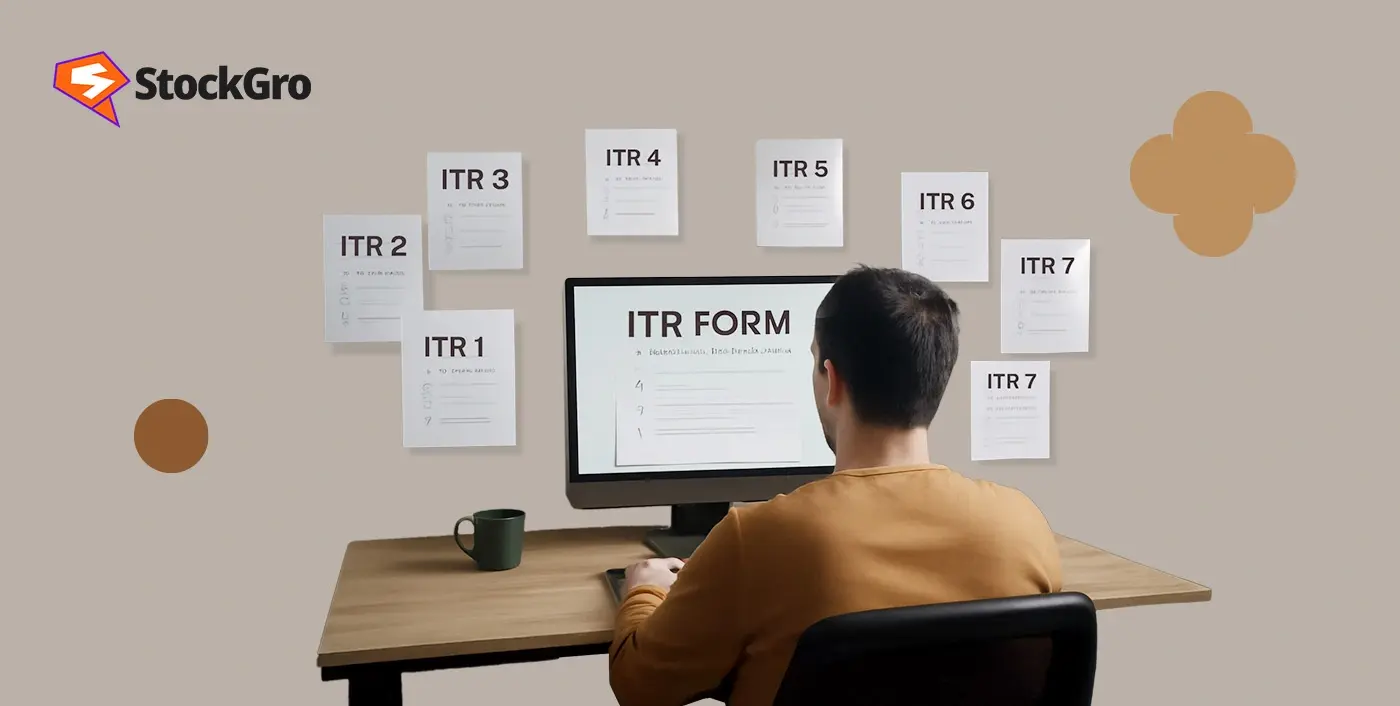
At the end of a financial year all taxpayers are required to pay income tax to the government. But did you know, to file taxes, there isn’t just a single standard form that everyone can fill?
Based on the source and amount of income of the taxpayer, the government has seven types of ITR (Income Tax Return) forms. Let us look at each type of ITR form and who can file them.
What is ITR?
Income Tax Return, or ITR, is a form that contains the income earned by an individual taxpayer or business entities in a financial year. This form also contains information regarding any deductions or exemptions. ITR helps claim refunds, writing off old losses (if any) and complying with the tax laws of the country.
The government has introduced seven different ITR forms, from ITR 1 to ITR 7. These forms are classified based on their income source and the amount of income earned.
ITR 1 and ITR 2 are ITR types for salaried people, and the rest are for different types of organisations.
An interesting read: Section 10 of the Income Tax Act: Claim Your Exemptions
Types of ITR forms
Let us take a look at each income tax ITR types:
| ITR Type | Source of Income | Eligible Taxpayer |
| ITR 1 | Salary / Pension / Other Sources / Agriculture (less than ₹5,000) | Resident Individuals, Income below ₹50 lakhs. |
| ITR 2 | Salary / Pension / Capital Gains | Individuals / HUFs, Income above ₹50 lakhs |
| ITR 3 | Business income / capital gains / multiple sources | Individuals/HUFs with business/professional income |
| ITR 4 | Business turnover < ₹2 crores / Professional Income < ₹50 lakhs | Businesses, Individuals choosing presumptive taxation |
| ITR 5 | Business / professional income | Firms, LLPs, AOPs, BOIs |
| ITR 6 | Business / professional income | Companies excluding those which are under Section 11. |
| ITR 7 | Income earned from organizations – Sections 139(4A to 4D) | Trusts, educational institutions, political parties |
ITR 1 (Sahaj)
A taxpayer fulfilling the following conditions can fill out the ITR 1 form:
- The taxpayer should be an Indian resident.
- Total income (for the financial year) has to be lower than ₹50 lakhs.
- The source of income should be a salary, pension, a single-family home, or income from agriculture (up to ₹5,000).
- Income includes earnings from various sources, and long-term capital gains up to ₹1.25 lakhs.
You cannot choose ITR 1, under the following conditions:
- Total annual income is more than ₹50 lakhs, and agricultural income is more than ₹5,000.
- The source of income is a business or a profession, or if the taxpayer is a director in a company.
- The annual LTCG earned is above ₹1.25 lakhs and is taxable.
- The income earned is from two or more house properties, or if the taxpayer holds an investment in unlisted shares.
- The income earner is not a resident of India or has any foreign assets or foreign income.
ITR 2
A taxpayer fulfilling the following conditions can fill out the ITR 2 form:
- The taxpayer can be a resident or non-resident individual. ITR 2 can also be used by a Hindu Undivided Family (HUF).
- The total annual income can be greater than ₹50 lakhs.
- The individual can hold the post of a director in a company.
- Apart from salary, pension and income from a single residence home, an individual with other incomes (winning the lottery) can also opt for ITR 2
- Individuals with investments in unlisted shares, or with foreign assets or foreign income.
- Agricultural income of more than ₹5,000.
You cannot choose ITR 2 under the following conditions:
- Profit earned from a HUF business or any income earned from being a partner at a partnership firm.
- Income earned from a profession or a business.
Also Read: Understanding Section 193: TDS on Interest from Securities
ITR 3
A taxpayer fulfilling the following conditions can fill out the ITR 3 form:
- The source of income is gains or profits from a business or a profession.
- The income is earned by a HUF business or an individual.
- Interest, salary, or profit-sharing earned by an individual by being a partner at a partnership firm.
You cannot choose ITR 3 under the following conditions:
- The source of income is not a business or a profession.
ITR 4 (Sugam)
Any kind of business entity apart from a limited liability partnership, like a HUF or partnership firm, can opt for ITR 4 by fulfilling the following conditions:
- The business income is calculated and taxed as presumptive income. (Under section 44AD and 44AE)
- Professional income is also calculated and taxed as presumptive income (Under section 44ADA)
- Income from salary, pension, or one house income is up to ₹50 lakhs.
- The turnover from business is not more than ₹2 crores.
You cannot choose ITR 4 under the following conditions:
- The total income earned throughout the year is more than ₹50 lakhs.
- Owning more than one housing property or if the individual has foreign assets.
- ITR 4 is not applicable to individuals who are company directors, hold investments in unlisted securities during the financial year, or have income from foreign sources.
ITR 5
Form ITR 5 can be used by:
- Limited liability partnership (LLP),
- Association of Persons (AOP),
- Artificial judicial person,
- Investment trust or a Business trust, etc.
- Body of Individuals (BOI)
This form cannot be used by trusts, institutions, political parties, and colleges (under section 139(4A to 4D))
ITR 6
Form 6 can be opted by those companies that do not claim any exemption u/s 11 (charitable or religious organisations).
ITR 7
This ITR form is applicable to individuals or companies filing income tax returns under sections 139(4A to 4D).
Also Read: A Look at Section 43B of the Income Tax Act: Key Provisions and Impact
Conclusion
Understanding different ITR forms types is essential for tax filing without making any errors. To prevent penalties, taxpayers must select the appropriate ITR form types that align with their specific income sources. Various types of ITR returns serve different taxpayer categories, and selecting the right one ensures compliance with tax regulations.
FAQs
What happens if you file the wrong ITR form?
Filing the wrong ITR form can lead to your return being treated as defective. The Income Tax Department may ask you to file a revised return using the correct form within a specified period. An incorrect tax return can be deemed invalid, potentially leading to penalties or the loss of your tax refund eligibility.
Which ITR form should freelance workers use?
Freelancers and gig workers earning through professional services can opt for either ITR 3 if they maintain books of accounts and have a regular income or ITR 4 if they want to choose presumptive taxation under Section 44ADA (provided total income is below ₹50 lakhs and no foreign assets are held).
Can a salaried person with taxable capital gains use ITR 1?
No. If a salaried individual has taxable capital gains, especially long-term capital gains (LTCG) exceeding ₹1.25 lakhs, or gains from unlisted shares or foreign assets, they should opt for ITR 2 instead of ITR 1. But if the gains are below ₹1.25 lakhs and are not taxable, then he can use ITR 1.
Can multiple ITR forms be filed simultaneously?
No, a business, an individual, or any other organisation, can only file one ITR form in a given financial year. If they file the wrong ITR form by mistake, they can file the revised form within the given deadline. But, you cannot file multiple ITR forms at once.
Can a person be subject to criminal proceedings if income tax is evaded?
Yes, if someone knowingly evades income tax, they can face criminal proceedings under the Income Tax Act. Depending on the severity, this can lead to penalties, prosecution, and even imprisonment ranging from 3 months to 7 years if the evasion amount exceeds ₹25 lakhs.

